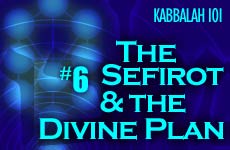 Iran’s Attack on Israel
Iran’s Attack on Israel


4 min read
God funnels His will through the primary Sefirot of intellect, creating a world where each event and interaction is part of a larger, comprehensible pattern.
We are now ready to introduce the Ten Sefirot -- the ten emanations of God.
At their fundamental level, the Ten Sefirot are a step-by-step process illuminating the Divine plan as it unfolds itself in our world. Remember once again, that the Ten Sefirot are not there because God could not do it all in one quick step, but rather in order for us to be able to gain insight and understanding of His deeds.
Let us divide the Ten Sefirot into groups that reflect this step-by-step process:
The planning of the deed: Chochmah (wisdom), Binah, (understanding), and Daat (knowledge).
The substance of the deed itself: Chesed (kindness), Gevurah (strength), and Tiferet (beauty).
The practical implication of the deed: Netzach (victory), and Hod (awe).
The enactment (or transfer) of the deed: Yesod (foundation).
The enacted deed: Malchut (kingship).
Let us take these groups individually, and get some feel for their significance.
THE FIRST GROUP
The first group consisting of Chochma, Binah and Daat, all relate to the realm of intellect. This is the group of "planning."
Just as a person’s plans and thoughts are never visible themselves, but only as manifested in one’s activities, so too are those very subtle Divine processes visible only within the context of the events that befall us. We extrapolate from the concrete realities around us, and we guess at the Divine wisdom that is the rationale behind these acts.
We believe that laws of physics exist, yet, no one has seen the formula for gravity in midair.
An experience parallel to this would be the way in which we look at the laws of physics. We believe that these laws "exist." Yet, no one has "seen" the formula for, say gravity in midair. Rather, every item that falls in our world follows this pattern, and we understand this to be the inner mechanism of the visible world around us. So too, as regards the Divine attributes of intellect, we always discern them within the framework of concrete Divine acts, but never as independent entities.
The fact that the first three of the Ten Sefirot can be grouped as relating to the intellect/planning has a tremendous ramification in our approach to grappling with God’s deeds and activities in this world. It means that God’s actions and deeds start with a platform of reason, and therefore we can never reduce Divine activity to mere fiat of diktat.
When a person acts straight out of whim, without reason, there is no way to impose an order or structure onto his activities. Each deed is a particular whim, perhaps only vaguely connected to the other deeds. But if a person is purposeful in his thinking and planning, then an integrated pattern can be discerned in what he does.
So too with God.
Because God chooses to act through the primary Sefirot of intellect/planning, we can understand each event and interaction as part of a larger, comprehensible pattern, as opposed to a series of isolated events.
Since all of God’s will funnels through a system of "Divine intellect," all of it can be explored intellectually at some level, and can be seen as integrated with His other activities, past and future.
THE PATTERN
We can discern the imprint of "Divine intellect" in the patterns that form the natural world, history and the laws of the Torah.
Let us see some of the manifestations of this:
a. The natural world.
It is clearly a very rigidly ordered place. There are consistent laws that rule this world. These laws are integrated with each other and form a clear pattern. The further advanced we get, the more we see that the laws of nature are like a tree with one root, branching out into many different categories of phenomena.
b. God's guidance of history.
As events happened they seem like a list of haphazard crisis and coincidences. But as we got a broader and longer perspective of history –- especially the history of Israel and its interactions with other nations -- we can pick out a unifying thread of Divine providence.
c. The laws of the Torah.
To a novice the laws of the Torah seem like a collection of odd prohibitions and proscriptions. But once we posit that all of these laws are not merely Divine dictates, but were first funneled through a common system of intellect/planning, then they must be seen as a unified system. To a large degree, Kabbalah tries to show the root system behind these laws.
